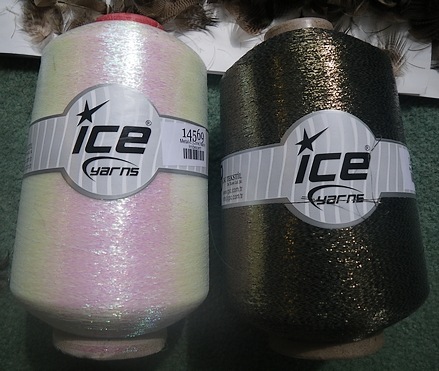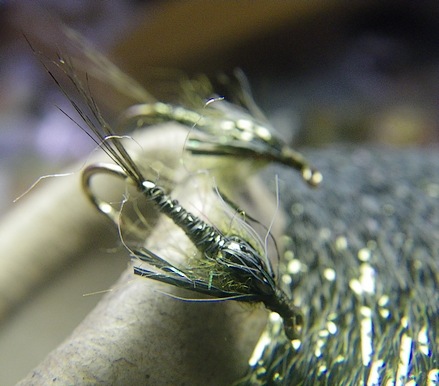Singlebarbed reader Spencer has trod where only the crazed and obsessed have dared and in traditional fashion I’ve started making excuses while flailing about trying to help.
“ … you mean you actually took my advice? That was your first mistake.”
The issue is simple. A dye manufacturer boasts of an olive or brown and both are complex colors made of multiple sub-colors. From your watercolor days, brown can be made a thousand different ways (usually by all the colors running together), but most vendors use a combination of reds and blues or orange and purple to get brown.
Spencer dutifully tossed in his really expensive Whiting neck he hasn’t owned up to inexpensive rabbit fur test chunk and wound up with a nice purple for his trouble.
Been there. Spent most of last weekend in the exact same place with RIT dye. If I knew more of what comprised color on the mineral side I might have a definitive answer, right now it’s lumped under “sucks to be you.”
Dyeing destroys a lot of materials during the learning process but over time you can handle certain types of calamities, the rest you dry and do your best to find a use for – the material hasn’t been destroyed, it’s just not the awesome medium olive you’d hoped it would become.
If you can’t get a brown to dye brown , there’s little you can do to fix it – and the only variables are listed below:
1) Heat – make the dye bath hotter or colder from the failed temperature. Some minerals may only dissolve at certain temperatures, so if you dye brown and get bluish purple, it could be the red is activated only by higher temperatures than the blue. Purple means that some red and blue fired, but blue-ish purple suggests more blue than red fired.
2) Over-dye or tint the color back into the acceptable range. It works best for lighter colors as you’re adding additional color to an already dyed material. Dyeing dark purple with yellow will have no effect, but dyeing a light green with some brown and yellow will yield an olive or olive tint.
3) Time – leave the mess in the pot overnight. This should only be done on the darkest colors as even Tan left overnight will yield a brown feather. Perhaps time is required to get the other color(s) to precipitate onto the feathers.
Over-dyeing is also not for the faint of heart, but it’s one of the ways you can get the rarified colors like bronze blue dun or a multi-colored feather.
Last weekend I’d agreed to reproduce some of Cal Bird’s teal colors and had approached the issue with great trepidation – Cal being a trained artist and therefore fully fluent in the manipulation of colors and tints.
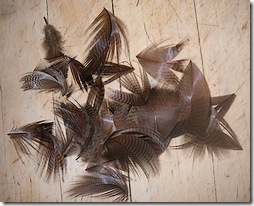 I’d dutifully followed the vendor’s color guide and built an olive and a brown from other colors. RIT lacks an olive, and their brown was too dark, so I mixed the custom colors in a proportion that I thought would yield something close…
I’d dutifully followed the vendor’s color guide and built an olive and a brown from other colors. RIT lacks an olive, and their brown was too dark, so I mixed the custom colors in a proportion that I thought would yield something close…
It didn’t, and I was left scratching my head like friend Spencer.
The dye was largely RIT forest green with about 10% RIT tan, but the green vanished no matter what temperature was used.
I yanked the feathers before they became too dark, but left a pinch of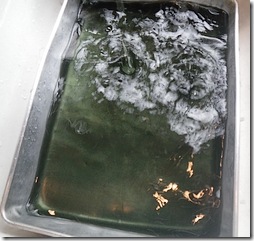 them in the pot to test the overnight method. The result is above, a rich dark brown.
them in the pot to test the overnight method. The result is above, a rich dark brown.
It didn’t matter what I tried, more heat, fixative, or dye yielded a pan full of forest green water and tan feathers. Over-dyeing was the only option, as I’d run out of suggestions from the manufacturer – who insisted I’d get an olive with the two colors mixed.
This drab, cold tan is shown below. It was yanked from the 90% green bath earlier – at the point when it had added all the tan needed to make the base color.
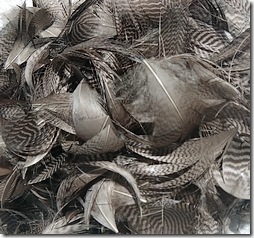
It has a miniscule amount of green in the feathers – just enough to turn the color cold.
I lump quasi-colors, those that I wasn’t expecting, under the destroyed feathers outcome; the colors are useful and the feathers are undamaged – only the end result is unexpected.
A couple days later I subjected the now dry “cold tan” feathers I’d pulled early, to a bath containing only green and a bit of yellow. I needed only the smallest tint of color added to warm it to the sample color.

The second bath applied what was missing to alter the color into the successful range. Green being equal parts yellow and blue and adding additional yellow – allowed the color to “warm” the feathers without obscuring the tan. There are hints of green in the feather duff at the base of each feather, but this is a brown-olive as dictated by the sample on the right.
Cal’s instructions are shown on the envelope, “olive and maple sugar.”
You can destroy feathers in millions of ways, with only a couple options to salvage the result. Consulting the color often allows you to pull the feathers when the unexpected results – and alters the problem from imbuing a light item with the finished color, to altering the existing color to match a desirable range.
Sorry, Spencer. It’s all part of the craft.
Tags: RIT, Cal Bird, teal, over-dyeing, tint, brown olive, bulk fly tying materials, custom dyed feathers, TINTEX maple sugar, whitefishcantjump.com, feather dyeing


